Subclass Elasmobranchii Scientific name Orectolobidae Rank Family | Phylum Chordata Order Orectolobiformes Higher classification Carpet shark | |
 | ||
Lower classifications | ||
The tasselled wobbegong shark lures in prey for ambush
Wobbegong is the common name given to the 12 species of carpet sharks in the family Orectolobidae. They are found in shallow temperate and tropical waters of the western Pacific Ocean and eastern Indian Ocean, chiefly around Australia and Indonesia, although one species (the Japanese wobbegong, Orectolobus japonicus) occurs as far north as Japan. The word wobbegong is believed to come from an Australian Aboriginal language, meaning "shaggy beard", referring to the growths around the mouth of the shark of the western Pacific.
Contents
- The tasselled wobbegong shark lures in prey for ambush
- New shark wobbegong hungry shark world ep 37 hd
- Description
- Interaction with humans
- Captivity
- Genera and species
- References

New shark wobbegong hungry shark world ep 37 hd
Description

Wobbegongs are bottom-dwelling sharks, so spend much of their time resting on the sea floor. Most species have a maximum length of 1.25 m (4.1 ft) or less, but the largest, the spotted wobbegong, Orectolobus maculatus, and banded wobbegong, O. halei, reach about 3 m (9.8 ft) in length.

Wobbegongs are well camouflaged with a symmetrical pattern of bold markings which resembles a carpet. Because of this striking pattern, wobbegongs and their close relatives are often referred to as carpet sharks. The camouflage is improved by the presence of small weed-like whisker lobes surrounding the wobbegong's jaw, which help to camouflage it and act as sensory barbs. Wobbegongs make use of their relative invisibility to hide among rocks and catch smaller fish which swim too close, typical of ambush predators.
Interaction with humans

Wobbegongs are generally not dangerous to humans. However, they have bitten people who accidentally step on them in shallow water or scuba divers who poke or touch them. Unprovoked, they may also bite divers, surfers, or snorkellers who swim near their hiding spots. Wobbegongs are very flexible and can easily bite a hand holding onto their tail.

They have many small but sharp teeth and their bite can be severe, even through a wetsuit; having once bitten, they have been known to hang on and can be very difficult to remove.

In Australia, the flesh of wobbegongs and other shark species is called flake and it is often the "fish" component of fish and chips. Wobbegong skin is also used to make leather.
Captivity
Although most wobbegong species are unsuitable for home aquaria due to their large adult size, this has not stopped some of the larger species from being sold in the aquarium trade. Small wobbegong species, such as the tasselled wobbegong and Ward's wobbegong, are "ideal" sharks for home aquarists to keep because they are an appropriate size and are lethargic, enabling them to be accommodated within the limited space of home aquaria, although they will consume tankmates, even quite large ones. Some aquarists, by contrast, see the lack of activity to be a drawback to keeping wobbegongs and prefer more active sharks. Wobbegongs are largely nocturnal and, due to their slow metabolism, do not have to be fed as often as other sharks. Most do well on two feedings weekly. Underfed wobbegongs can be recognised by visibly atrophied dorsal musculature.
Genera and species
The 12 living species of wobbegong, in three genera, are:
Fossil genera include:
